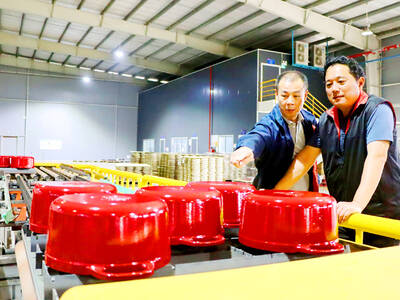Taiwan’s annual energy reserve capacity margin could consistently drop to below 10 percent by 2018, as the planned power generation capacity might not meet rising domestic energy demands, sharply increasing the chance of power shortages, state-run Taiwan Power Co (Taipower 台電) said yesterday.
The prediction of the potential shortage has been moved forward two years partly due to a delayed replacement of the Tongxiao natural gas-fired power plant (通霄電廠) in Miaoli County, the company said.
Taipower said it initially encountered difficulties in obtaining construction licenses.
“The energy reserve capacity margin could plunge to 4.8 percent by 2019 following the retirement of the second reactor of the Jinshan Nuclear Power Plant in New Taipei City’s Shihmen District (石門),” Taipower spokesman Roger Lee (李鴻洲) said at a press conference.
The annual power reserve capacity margin refers to a utility’s capacity to generate more energy than the total power system normally requires.
Taipower said it is better to maintain the reserve margin of 15 percent as insurance against breakdowns or a sudden surge in electricity demand.
Every year, Taipower releases a forecast of annual power reserve capacity for the next few years based on the nation’s electricity demand and economic growth.
Lee said this year’s reserve capacity margin is 10.4 percent, down 4.3 percentage points from last year’s 14.7 percent, due to the retirement of two power generation units of a coal-fired power plant in Linkou District (林口), New Taipei City.
Based on past records, the nation could face power rationing measures if the energy reserve margin drops below 7.4 percent, Lee said.
“To reduce the chance of power shortages, the nation has to conserve energy and the government must speed up the installation of renewable energy sources, such as solar and wind power generation,” Lee said.
In a separate press conference, the Bureau of Energy said it plans to increase its power contribution to renewable energy sources from this year’s 11.6 percent to 30.7 percent by 2030.
In a bid to accelerate the diversification of Taiwan’s energy sources and deal with the increasing risk of power shortages, the bureau is to boost the target for total installed capacity of renewal energy sources to 17,250 megawatts (MW) by 2030 from the previous target of 13,750 MW, bureau Director-General Lin Chuan-neng (林全能) said.
“We plan to relax the bidding regulations for solar power and wind power installations to achieve our target,” Lin said.

TAKING STOCK: A Taiwanese cookware firm in Vietnam urged customers to assess inventory or place orders early so shipments can reach the US while tariffs are paused Taiwanese businesses in Vietnam are exploring alternatives after the White House imposed a 46 percent import duty on Vietnamese goods, following US President Donald Trump’s announcement of “reciprocal” tariffs on the US’ trading partners. Lo Shih-liang (羅世良), chairman of Brico Industry Co (裕茂工業), a Taiwanese company that manufactures cast iron cookware and stove components in Vietnam, said that more than 40 percent of his business was tied to the US market, describing the constant US policy shifts as an emotional roller coaster. “I work during the day and stay up all night watching the news. I’ve been following US news until 3am

Six years ago, LVMH’s billionaire CEO Bernard Arnault and US President Donald Trump cut the blue ribbon on a factory in rural Texas that would make designer handbags for Louis Vuitton, one of the world’s best-known luxury brands. However, since the high-profile opening, the factory has faced a host of problems limiting production, 11 former Louis Vuitton employees said. The site has consistently ranked among the worst-performing for Louis Vuitton globally, “significantly” underperforming other facilities, said three former Louis Vuitton workers and a senior industry source, who cited internal rankings shared with staff. The plant’s problems — which have not

TARIFF CONCERNS: The chipmaker cited global uncertainty from US tariffs and a weakening economic outlook, but said its Singapore expansion remains on track Vanguard International Semiconductor Corp (世界先進), a foundry service provider specializing in producing power management and display driver chips, yesterday withdrew its full-year revenue projection of moderate growth for this year, as escalating US tariff tensions raised uncertainty and concern about a potential economic recession. The Hsinchu-based chipmaker in February said revenues this year would grow mildly from last year based on improving supply chain inventory levels and market demand. At the time, it also anticipated gradual quarter revenue growth. However, the US’ sweeping tariff policy has upended the industry’s supply chains and weakened economic prospects for the world economy, it said. “Now

COLLABORATION: Given Taiwan’s key position in global supply chains, the US firm is discussing strategies with local partners and clients to deal with global uncertainties Advanced Micro Devices Inc (AMD) yesterday said it is meeting with local ecosystem partners, including Taiwan Semiconductor Manufacturing Co (TSMC, 台積電), to discuss strategies, including long-term manufacturing, to navigate uncertainties such as US tariffs, as Taiwan occupies an important position in global supply chains. AMD chief executive officer Lisa Su (蘇姿丰) told reporters that Taiwan is an important part of the chip designer’s ecosystem and she is discussing with partners and customers in Taiwan to forge strong collaborations on different areas during this critical period. AMD has just become the first artificial-intelligence (AI) server chip customer of TSMC to utilize its advanced